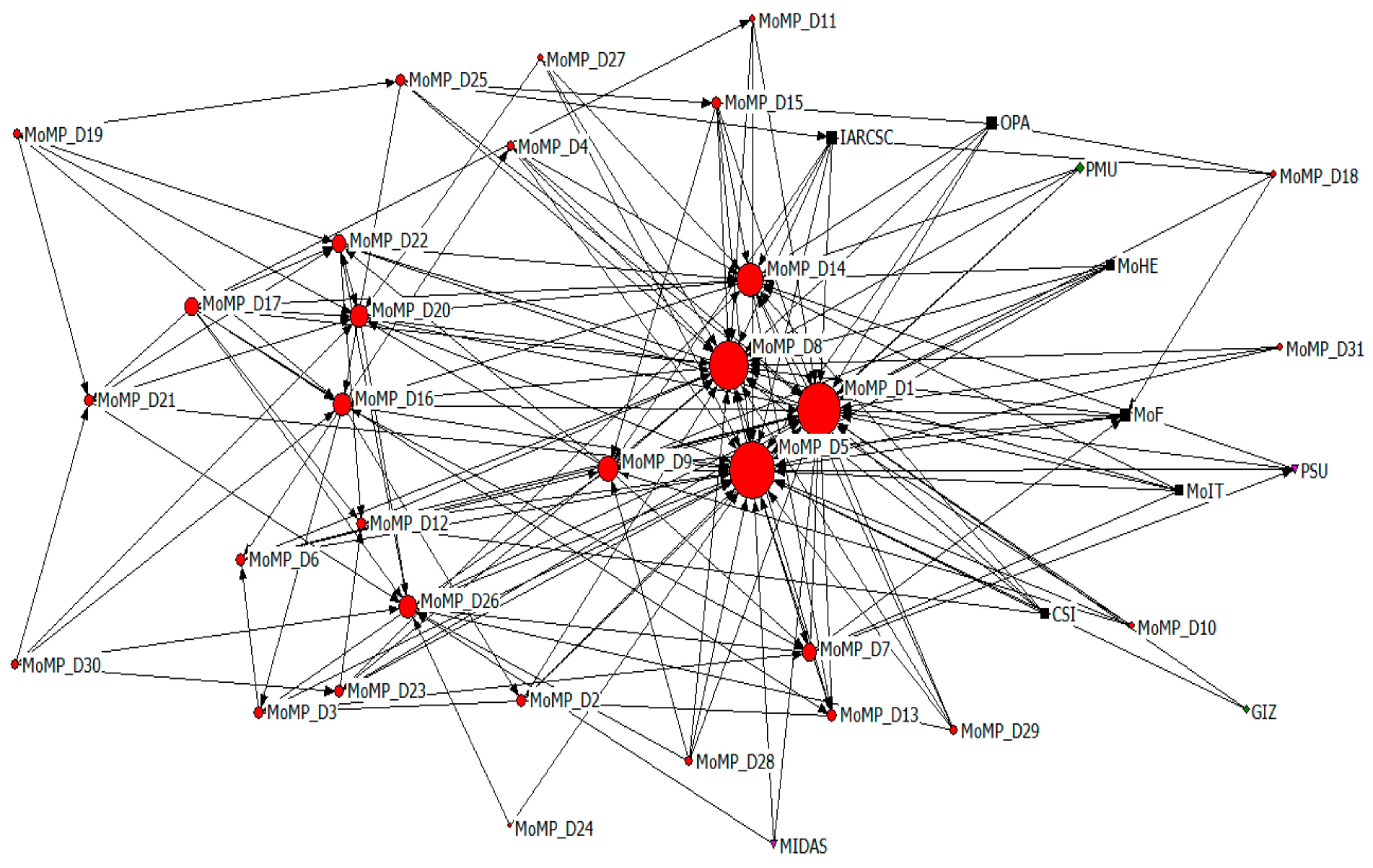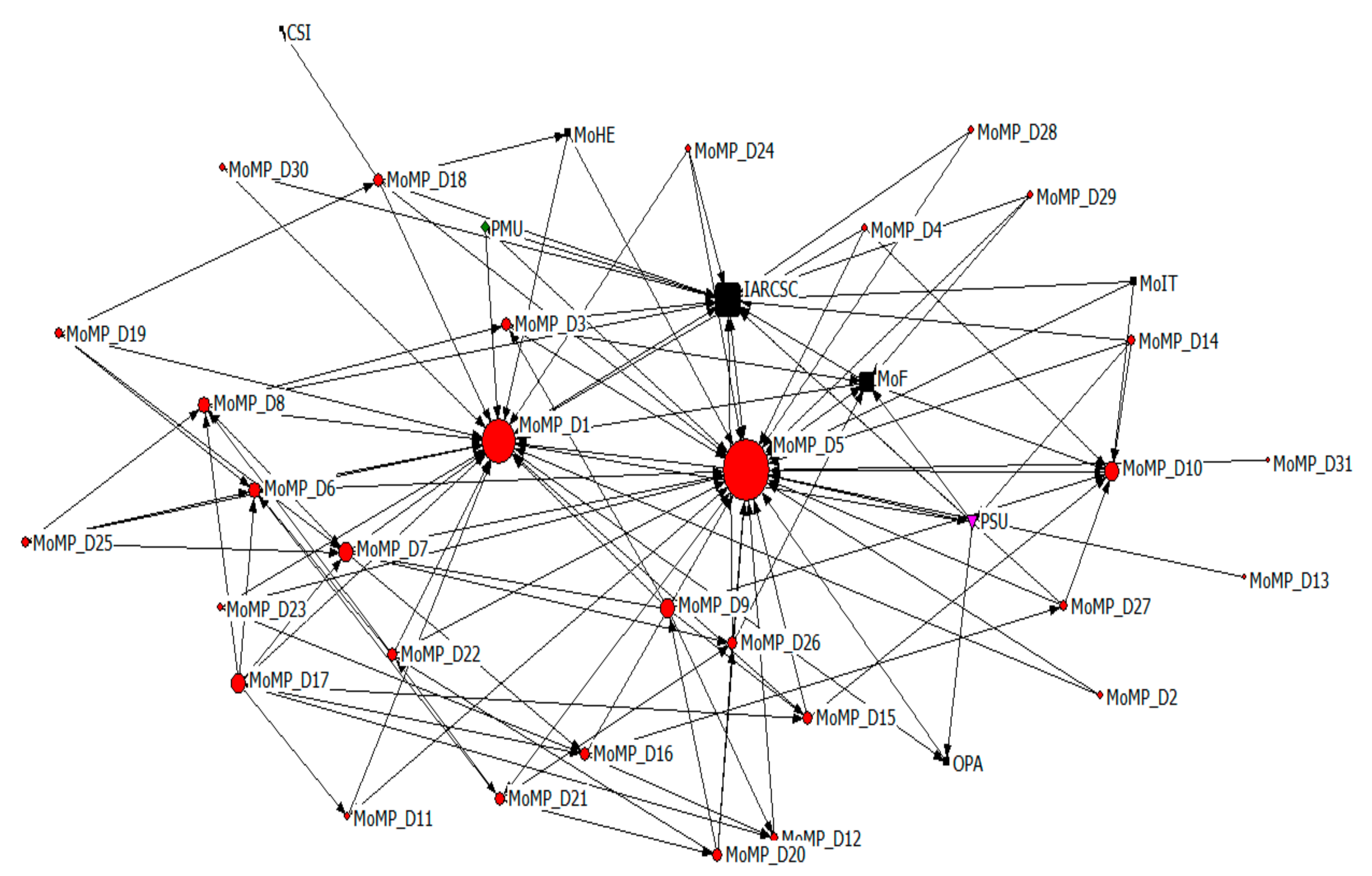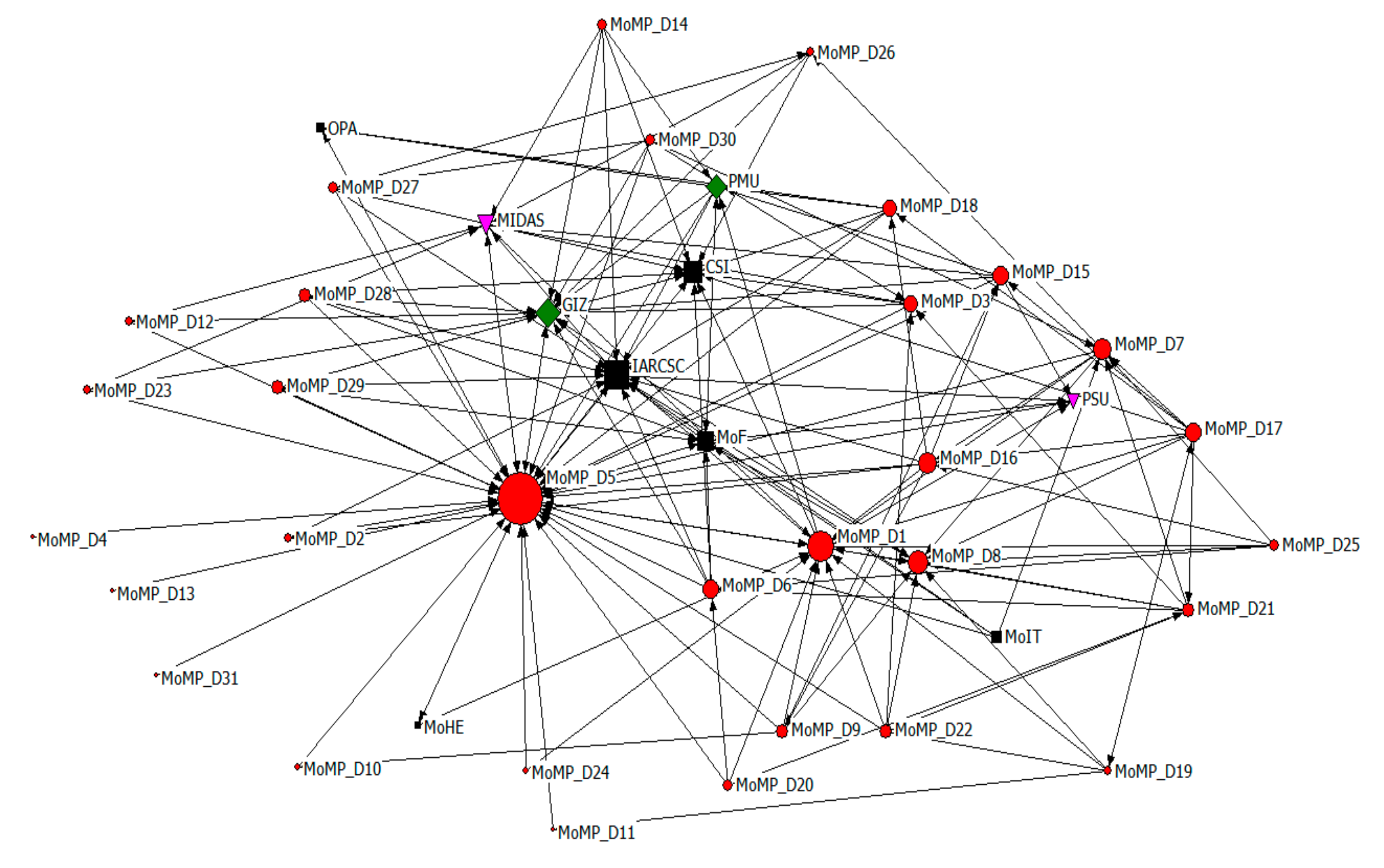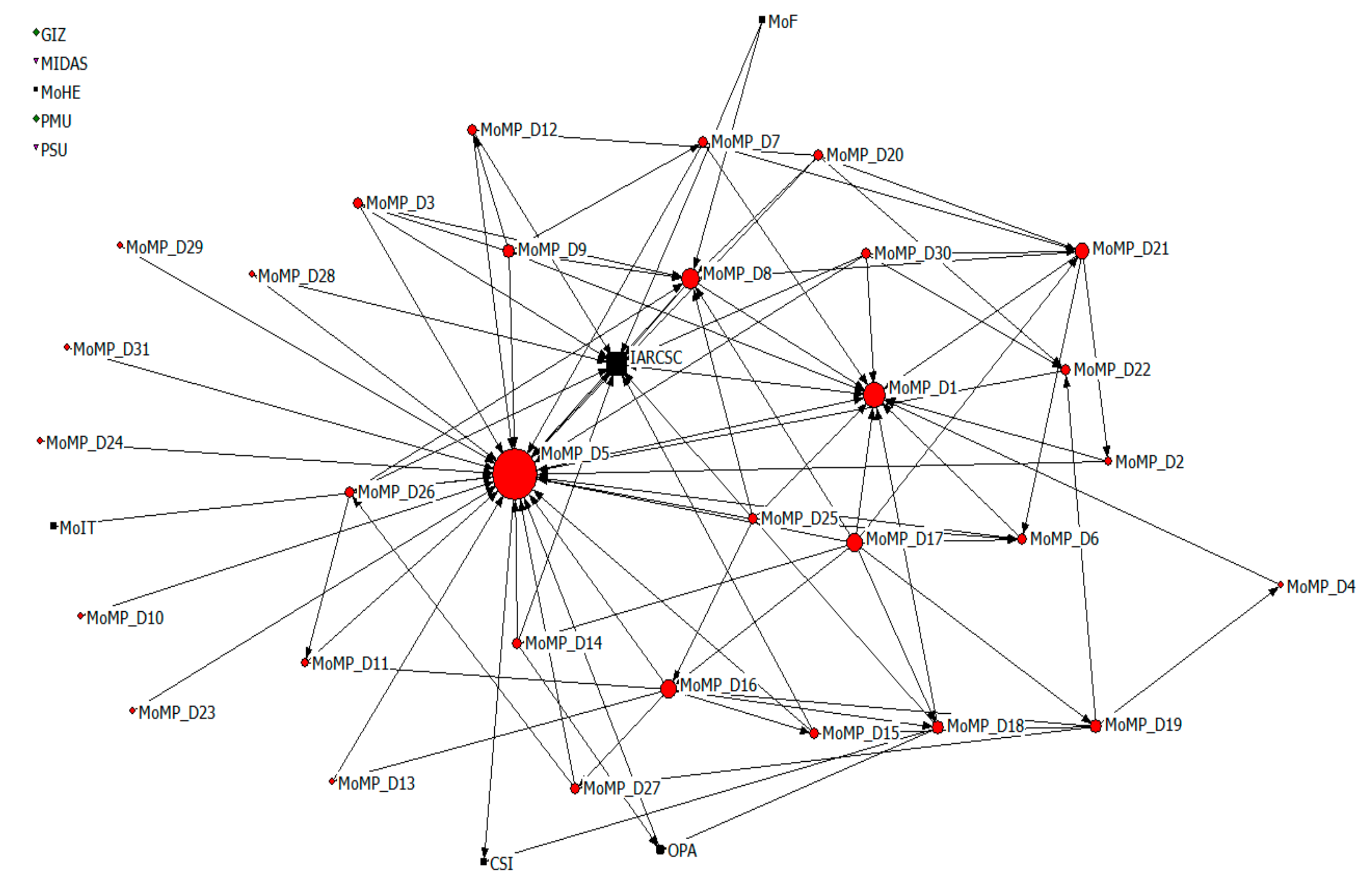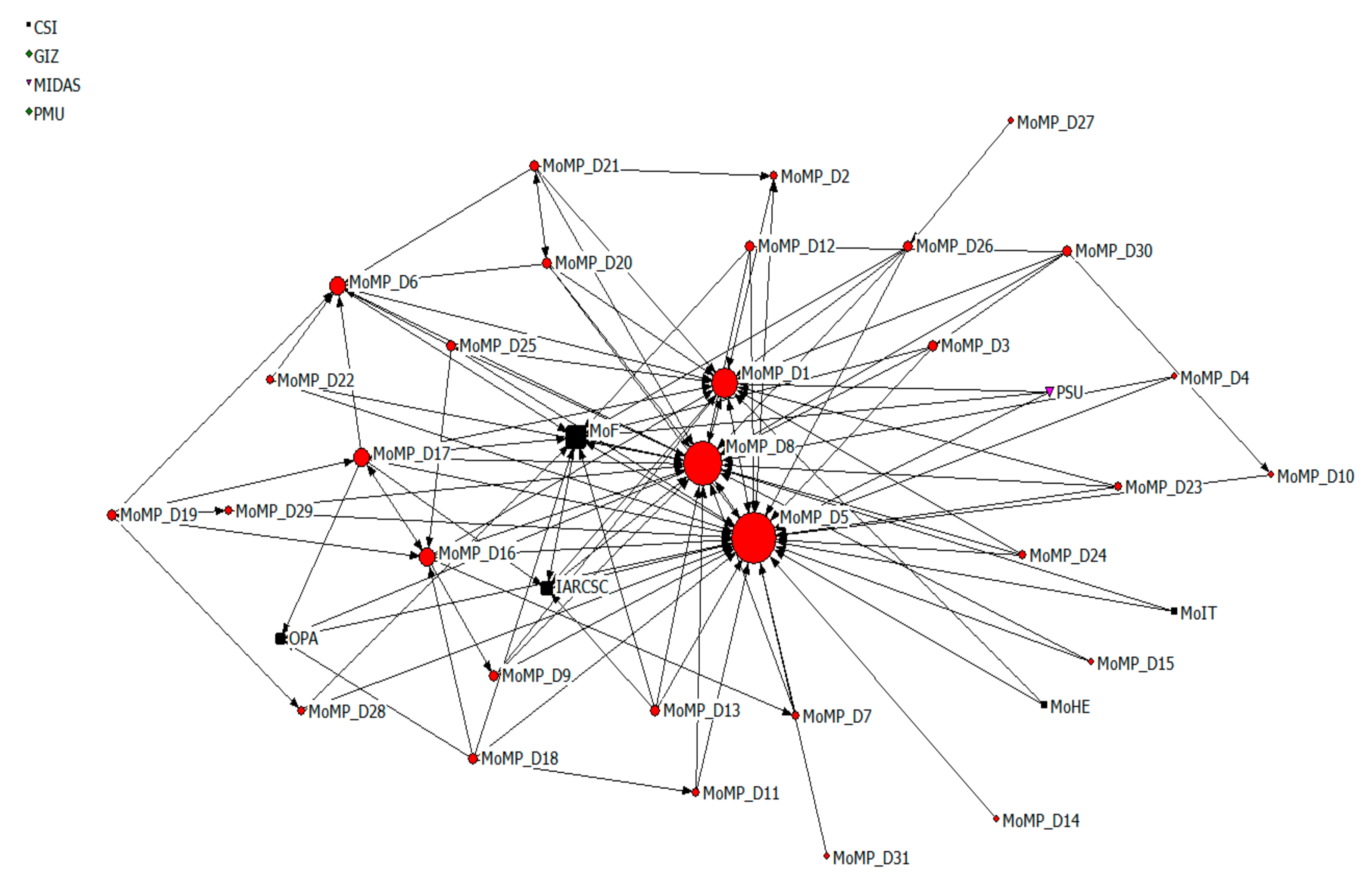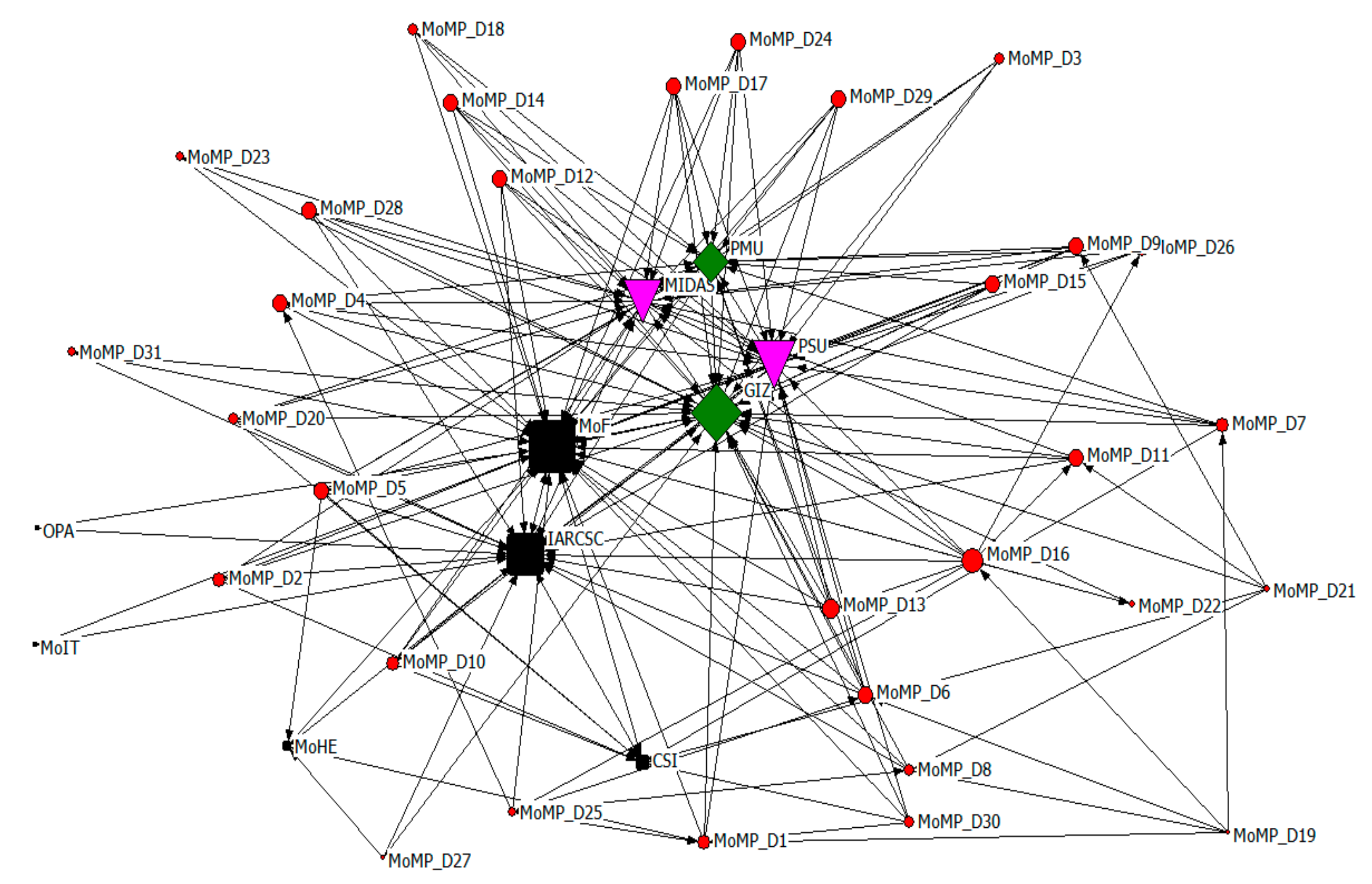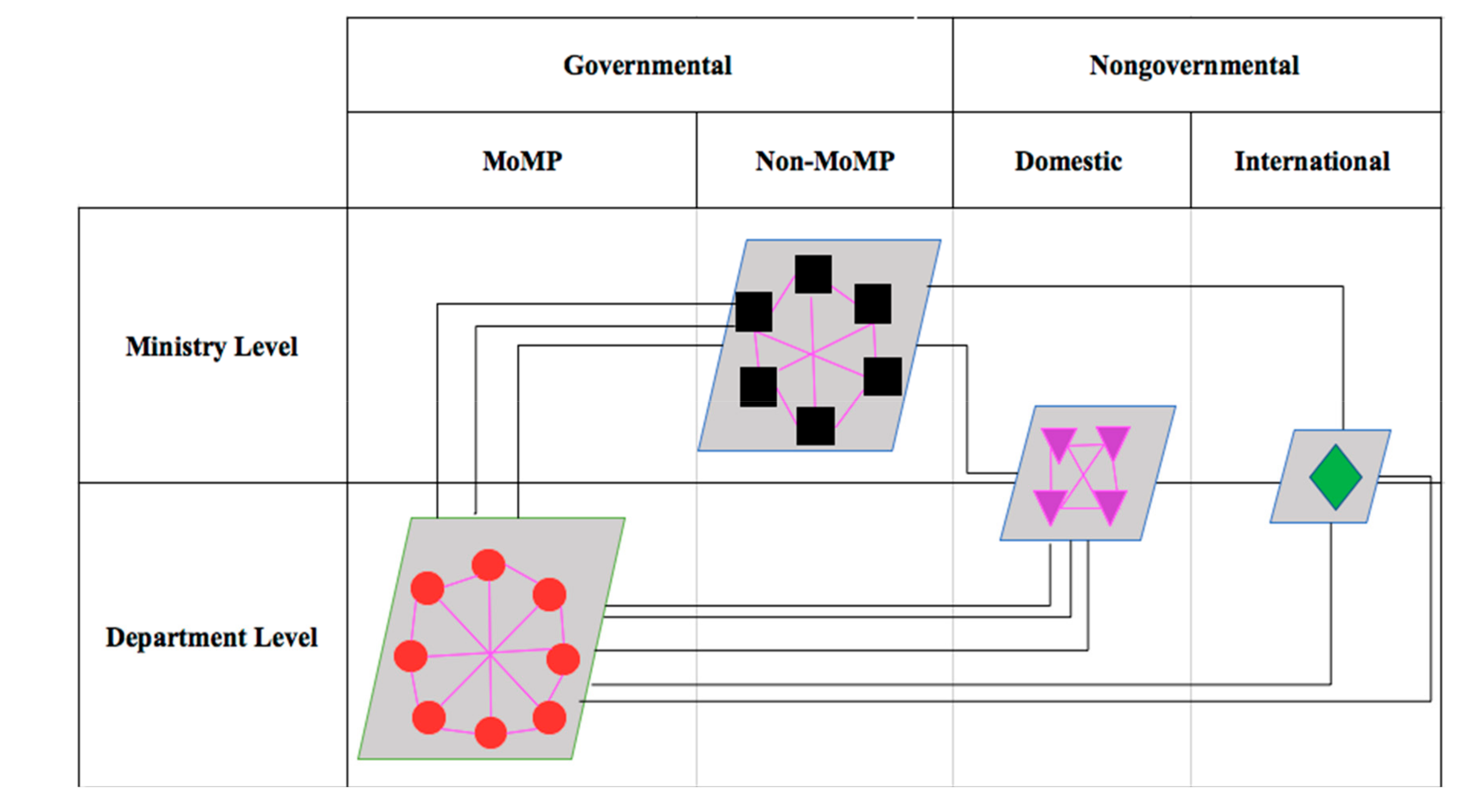1. Introduction
The Ministry of Mines and Petroleum (MoMP) is one of the leading ministries of the Afghanistan government and is responsible for managing and controlling natural resources in Afghanistan [
1]. The Human Resources (HR) department is one of the vital departments of the MoMP. It is responsible for managing HR according to the civil servant law and the national strategy for the mining sector in Afghanistan and particularly for the MoMP. The HR department of the MoMP initially functioned as a traditional administrative personnel department and was designed primarily to follow Soviet norms and procedures. In 2001, when the Taliban regime collapsed, a new provisional government was established based on the Bonn agreement. Subsequently, the Independent Administrative Reform and Civil Service Commission was established in June 2003, and it became responsible for civil service management and public administration reform [
2]. The commission developed legislation, policies, and procedures that intended to modernize human resource management (HRM) practices in Afghanistan’s public organizations. However, the implementation of this reform was challenging due to certain factors such as low personnel capacity in the newly formed HR departments of Afghanistan’s public organizations, particularly the MoMP. Nevertheless, through implementation of the reformed HRM policies and procedures throughout public organizations in Afghanistan, some positive changes occurred in terms of organizational structures and employee performance [
2]. Due to the current conditions of the public sector in Afghanistan, however, the implemented reforms were unable to satisfy the public. Therefore, a need to apply more reforms and introduce new concepts of administrative systems remains, particularly in the HRM field. These are necessary to improve the productivity of public organizations, while providing services to satisfy the Afghan public.
In this study, the primary focus is the current state of HRM in Afghan public organizations, particularly the MoMP, to determine whether there are any strategic human resource management (SHRM) aspects such as collaboration among HR departments and other stakeholders both inside and outside the organization. In addition, this paper examines how the HR department within the MoMP collaborates with other departments or outside organizations and stakeholders to execute its practices. Furthermore, this paper discusses whether the HR department is involved in organizational goal-setting and decision-making processes, which are other aspects of SHRM. Finally, the primary aim of this study is to evaluate current HRM in Afghan public organizations, particularly in the MoMP, to determine the gaps between HRM and SHRM and provide remedies and recommendations for expanding the HRM landscape concerning SHRM in Afghan public organizations—again, particularly with regard to the MoMP. Therefore, this paper seeks to answer the following research questions: First, how does the HR department collaborate with other departments and organizations in the ministry-level goal-setting of the MoMP? Second, how—and with which departments and stakeholders—does the HR department collaborate to develop and implement HRM practices, including recruitment, training, appraisal, and rewards, within the MoMP?
2. Strategic Human Resource Management (SHRM)
The basic concept underlying HRM is addressing individuals’ issues by focusing on traditional practices, including recruitment, performance appraisal, rewards, and training from a micro viewpoint [
3]. Because of new trends in recent years, the HRM field has incorporated strategic management processes to develop a new concept referred to as SHRM [
4].
The SHRM model represents an advanced model of HRM that can help HR departments to become proactive and effective parts of the decision-making processes of organizations [
5]. The relationship between HRM and strategic planning has been found to be a critical component of many aspects of SHRM [
6]. HRM practices can play a role in supporting strategy execution because the HR department can help the agency determine whether the organizational strategy is realistic given the present levels of human resources. Under SHRM, HR practices that play a strategic role tend to be distinguished by their focus on the contributions of HR practices to organizational long-term goal-setting, and on linking HR practices to the overall directions of organizational objectives and plans [
7,
8]. HRM can be proactive in developing a two-way relation, where its influence on strategic planning, strategy formulation, and goal-setting will be recognized because every task that is completed in an organization requires some type of resource (e.g., people (HR) and money) [
9]. Therefore, according to Lim et al. [
5], organizations should consider that the HR department is important for determining its overall strategic goals and priorities. Likewise, one of the main focuses of SHRM is to support the involvement of HRM in developing strategic organizational goals [
10,
11].
Basically, five differences have been identified between traditional HRM and SHRM (see
Table 1) [
5]. First, traditional HRM pays more attention to individual characteristics such as job performance, level of job satisfaction, and what an employee actually needs to be successful within an organization. SHRM concentrates on the relation between organizational strategic plans and HR practices, and the impact of its relation with organizational performance. Second, traditional HRM focuses on HRM practices from a micro-level point of view, whereas SHRM aims to promote more widespread optimization through the vertical and horizontal alignment of HR practices and is based on a macro-level viewpoint [
12,
13]. Third, the time horizon is extended. Traditional HRM is more concerned with solving current organizational problems, which requires less time to address; in contrast, SHRM involves launching organizational policies and strategic plans to develop human capital from a long-term perspective [
5]. Thus, fostering the human assets of an organization will ensure that it is well organized and that all of its tasks are coordinated. HRM works with individual departments to help them attain their goals but also seeks to have a positive impact on organizational objectives as well. Fourth, traditional HRM functions are assumed to have no connection to attaining organizational objectives and are considered to have a minor and limited role in overall organizational aims. SHRM involves HR professionals and top managers in the development and implementation of organizational policies and strategies, seeks to steadily improve and boost the strategic function of HR, and empowers organizational members rather than solely monitoring them [
5]. Therefore, HR practices need to play a more strategic role in facilitating collaborations with non-HR practices. The goal is to develop and execute HRM practices that are aligned with organizational goals, thus expanding HRM beyond its traditional administrative role as a peripheral supporting function within an organization.
The aforementioned primary differences between traditional HR and SHRM clearly indicate that SHRM has the ability to ensure that all HR practices are aligned with organizational missions, visions, and goals, which can help it achieve its goals and objectives. HR professionals can play a critical role in determining organizational strategies, and goals and must be considered at higher levels (such as departmental or organizational) [
4]. However, it would not be possible for SHRM to help the organization reach its goals unless the HR department effectively collaborates with other departments that are a part of the organization. Looking back at the main theories of SHRM, the so-called Michigan model by Fombrun et al. [
14] paid attention to how contextual factors influence HRM practices, and the so-called Harvard model by Beer et al. [
15] explicitly focused on the impacts of interactions between stakeholder interests and situational factors on setting HRM priorities in organizations. That is, under the SHRM paradigm, the HR department does not work independently, but rather interacts and cooperates with other departments in the organization as well as with stakeholders outside of the organization to understand their goals and to create strategies aligned with those objectives and those of the organization [
5,
16]. Scholars agree that organizations must value the collaboration between HR and other departments and external stakeholders, and well-coordinated HRM can improve organizational effectiveness [
17,
18]. Additionally, HR managers are occasionally involved in developing SHRM plans and policies together with senior line and top management officials for the execution of policies and procedures [
19]. In some countries, HR managers do not make decisions on HR practices alone, while in other cases HR managers have even been excluded from participating in HRM practices [
20]. For HRM to be involved in organizational goal-setting, it is better to shift from HRM to SHRM and consider how this change could contribute to the roles and functions of HRM in setting goals and being involved in organizational decision-making processes.
Furthermore, based on stakeholder theory [
21,
22], the definition of SHRM has recently been expanded to incorporate the concept of sustainability in order to emphasize how to achieve organizational effectiveness not only from internal organizational members’ (including managers’ and employees’) perspectives, but also from external stakeholders’ (including public service recipients’, citizens’, external fund providers’, and donors’) needs, expectations, and desires [
16,
23,
24,
25,
26,
27] (for recent empirical research on sustainable HRM, see an entire special issue of
Sustainability [
28,
29]). Therefore, SHRM approaches focus more on the interactions among multiple internal and external stakeholders comprising and influencing the HRM functions of an organization and organizational long-term survival and sustainability. However, despite the advent of an era of collaborative multi-organizational settings [
30,
31], the roles and relationships of key internal and external stakeholders, which directly or indirectly affect or are influenced by HRM systems, have not been empirically examined [
16].
3. Traditional and Reformed HRM in Afghan Public Organizations
The agency in charge of HRM issues was previously called the Personnel Management Department (PMD) and acted as a general management office for all the public organizations in Afghanistan. When political changes occurred in Afghanistan, the governance system also changed. The new provisional government was established based on the Bonn agreement in 2001, then the Independent Administrative Reform and Civil Service Commission (IARCSC) was established in 2003 to focus on civil service management and public administrative reform [
32].
The IARCSC was decisive in accomplishing significant enhancements throughout the public administration, specifically in establishing the norms and practices of merit-based HRM functions [
33]. The IARCSC has accomplished many achievements, particularly those related to HRM, in public service institutions over the last 15 years [
2]. One significant achievement of the IARCSC is the shift from traditional HRM, which was implemented by the PMD, to reformed HRM (see
Table 2). Before the reform, most HR practices were completed in their primitive form in Afghan public organizations, which operated under the most basic HRM rules and procedures.
The previous HRM system that was instituted by the PMD changed slightly after reform programmes were implemented (see
Table 2). There were minor changes made between the traditional HRM and the reformed HRM in Afghan public organizations, particularly in the MoMP. These changes were evaluated based on four aspects: focus of analysis, scope of analysis, span of time, and the functions and roles of HRM. In Afghan public organizations, traditional HRM typically addressed more traditional aspects; for instance, before the reform, tests or examinations were not required for becoming a public official. One could become a public official merely by obtaining approval from the minister or deputy minister, and the PMD was responsible only for processing the employee’s recruitment documents. The focus of the PMD was only on hiring employees based on the minister’s approval. The process did not consider an individual’s characteristics or aspects such as job performance and employee motivation. After the reformation of HRM, exams became compulsory, and the focus expanded to consider individuals’ characteristics and other important aspects such as job performance, employee incentives, and capacity-building.
The previous traditional HRM system was responsible for only two practices: recruitment and reward. These two practices were implemented not according to a merit system, but according to a primitive form and traditional methods. In contrast, reformed HRM aims to become more effective and focus on what the employees need to be successful within organizations [
2]. The traditional HRM emphasized short-term programmes that were limited to recruiting and rewarding practices, while the reformed HRM focuses on short-term goals and problem-solving that include all the practices of HRM. In the last stage, traditional HRM activities were limited to setting goals only for recruitment practices. In contrast, the reformed HRM involves establishing goals for the whole HR department that align with organizational-level goals and objectives [
2].
4. Research Design
To answer the research questions of this study and provide implications for expanding the HRM landscape to include SHRM in Afghan public organizations (particularly in the MoMP), the following steps were used to conduct this research:
Face-to-face interviews were conducted with 31 high- and mid-ranking public officials representing each department of the MoMP (i.e., internal stakeholders) and with agents of 10 external stakeholders outside of the MoMP;
The collected data were analysed using social network analysis (SNA) methods; and
Relevant reports were compiled to show the results of the research.
In this study, SNA was utilized to analyse the formation of networks for each practice of HRM that was identified in the MoMP. SNA uses graph theory to explain the structure of networks and analyse the links among the actors in the networks [
34]. SNA can also be defined as a set of systematic tools used to build networks of actors that can be effectively used to measure and foster collaboration in strategically critical groups such as agencies [
35]. Organizations, people, and participants can all be considered as nodes in the SNA [
36]. Network analysis assesses actors and their relationships in an interconnected process. In this study, each organization or department is regarded as an actor.
In SNA, a powerful and important actor in a network can be detected by centrality measures. Centrality measures represent the levels of collaboration, cooperation, connectivity, and communication that constitute typical goals for forming network structures [
37]. Three types of centrality measures were used in this paper: in-degree, in-closeness, and betweenness. Each measure reveals the location and importance of actors from several different viewpoints [
37]. The in-degree centrality measure identifies the most significant actors by counting the number of incoming ties from the other actors in a specific network [
38]. The more links an actor has in a network, the more pivotal that actor is in the network. Collaboration and cooperation can be sustained through strong actors with more connections with other actors in a network; therefore, an actor with more and stronger ties would likely be a more important actor in a collaborative network [
37,
39]. For example, in the performance and appraisal network, the coordinator of the performance appraisal programme, as an actor, would likely have more ties than other actors in the network.
The closeness centrality measure is used to identify the main actor by determining how close an actor is to other actors in terms of distance. In-closeness centrality indicates “the extent to which an actor is close to, or can easily reach, all the other actors in the network and is usually measured by averaging the path distances of the direct and indirect links to all others” [
35]. In other words, the in-closeness centrality measure is used to examine the level of communication under the assumption that the smaller the distance between an actor and other actors is, the faster the communication will be [
40].
The betweenness measure identifies important mediating actors in terms of their positional power in a network. In other words, betweenness indicates “the extent to which an actor mediates, or falls between, any other two actors on the shortest path between those two actors and is usually averaged across all possible pairs in the network” [
32]. More profoundly, an actor with betweenness power can provide communication linkage between two other actors in a network. Notably, the isolate concept is also used in this study to identify actors with no connections to any other actors in the network [
35].
To collect the relational data indicating the connections among the actors involved, face-to-face interviews were first conducted with 31 public officials of the MoMP selected by purposive snowball sampling [
39,
41,
42]. Purposive snowball sampling aims to (i) identify the relevant stakeholders and define the appropriate boundaries of their networks, and (ii) determine their relationships with other stakeholders [
43]. More specifically, this sampling method first requires careful selection of initial actors with the most relevant knowledge and reliable information about the researchers’ targeted topics of the study, then having those initial actors recommend or nominate other critical actors who could be added to capture the more exact boundary of the networks. The actors nominated by the initial actors are also given an equal opportunity to respond to surveys and reveal their links with other actors involved in the targeted networks. Rounds of referrals and recommendations continue until the names of actors become saturated and the boundary of the targeted networks has been expanded for investigating more comprehensive and representative relationships among the actors.
The initial respondents and interviewees were 31 heads of departments within the MoMP, representing the inside stakeholders of this study. Because 10 outside actors were recommended to be included in our target networks, interviews were additionally held with (i) representative officials, who were all heads of their departments but did not work for the MoMP, (ii) representatives of nongovernmental organizations consisting of domestic agencies that shared goals with the MoMP, and (iii) representatives of the international agencies supporting the HR department in their efforts to improve practices. The MoMP’s stakeholders were categorized into four groups: (1) governmental organizations within the MoMP, (2) governmental organizations outside the MoMP, (3) domestic nongovernmental agencies, and (4) international organizations (see
Table 3).
A questionnaire was designed to collect the required information from respondents regarding the HR department’s collaboration with other stakeholders both inside and outside the MoMP (i.e., horizontal alignment of HR practices with other stakeholders) and the involvement of the HR department in setting ministry-level goals (i.e., vertical alignment of HR practices with broad organizational goals) [
5,
27]. The overall goal of designing the questionnaire was to identify whether there are any aspects of SHRM apparent in the MoMP or not. The survey included six questions that were used to (i) determine whether the HR department performs a strategic role by actively engaging in the organizational goal-setting process of the MoMP (i.e., “With which departments/organizations does your organization/department collaborate to set the Ministry-level organizational goals within the Ministry of Mines and Petroleum or outside stakeholders?”), and (ii) assess the interactions between the HR department and its inside and outside stakeholders in the networks of four main HR practices with the funding for capacity-building network (for example, in the case of the recruitment practices network, “With which agencies/departments does your organization/department collaborate regularly concerning human resource activities/practices for the purpose of designing and implementing a recruitment system of civil servants in the Ministry of Mines and Petroleum?”). The respondents were asked to list three to five main partners based on their understanding of each network, including the ministry-level goal-setting network, recruitment practices network, training practices network, performance appraisal practices network, reward practices network, and funding for capacity-building network.
5. Results
5.1. Main Actors in the Organizational Goal-Setting Network
Table 4 shows the five leading actors ranked based on their centrality measures for in-degree centrality, in-closeness, and betweenness in the organizational goal-setting network. The top five actors in the organizational goal-setting network had different positions. For example, the HR department (MoMP_D5) ranked first for the in-degree measure. MoMP_D5 was indicated by 31 actors (who represented either the ministry departments or outside stakeholders) to be the most important actor in the ministry-level goal-setting process. Furthermore, MoMP_D5 also ranked first for both the in-closeness and betweenness measures. This result indicates that most of the departments within the MoMP communicate with each other through the HR department. In other words, if one department needs to contact another one, it needs to pass through the HR department. In addition, according to
Figure 1, the size of MoMP_D5’s node and its central position in the network indicate its importance for ministry-level goal-setting. The results for the centrality measures indicate that MoMP_D5 is the most significant and powerful communicator in the network.
Figure 1 indicates that MoMP_D5 has the highest centrality values and is a central actor for setting ministry-level goals; this also indicates that this department is an active and powerful communicator. These results indicate that the SHRM feature of being involved with and determining the primary goals of agencies is noticeable in the MoMP.
Another example is the Office of the Minister (MoMP_D1), which ranked second for both the in-degree and in-closeness measures; however, it ranked third for the betweenness measure. Additionally, as demonstrated in
Figure 1, MoMP_D1 has the second-largest node in the network, which indicates that it is the second-most dominant actor in this network. Indeed, because of procedures and hierarchy, MoMP_D1 was expected to be a central player in setting ministry-level goals. However, MoMP_D5 engages in a higher level of collaboration and coordination both within and outside the MoMP for setting ministry-level goals; therefore, it is in the leading position in this network.
As shown in
Table 4, the finance and accounting department (MoMP_D8) appears to be the third-most influential actor in this network. Because this department manages the finances used for setting the ministry’s goals and ensuring their achievement, MoMP_D8 ranked as the third key actor in this network. In addition, the Department of Economic Analysis and Policy Design (MoMP_D14) ranked fourth for both the in-degree and in-closeness measures, and ranked second for the betweenness measure. Therefore, MoMP_D14 is the fourth-most important actor in the network for setting ministry-level goals. The General Directorate of Geological Surveys (MoMP_D26) is among the top five actors in
Table 4. The results for the in-degree and in-closeness measures indicate that MoMP_D26 is important. This department did not rank among the top five actors for the betweenness measure, but can be considered the fifth-most significant actor for the organizational goal-setting network. MoMP_D26 is a general directorate in the MoMP and is responsible for surveying all the mines in Afghanistan. Therefore, these results indicate that this department is a central actor in the organizational goal-setting network.
5.2. Key Actors in the Recruitment Practices Network
According to the procedures for the reform published by the IARCSC, the HR department is responsible for managing the recruitment process for each public organization. As a practice of HRM, recruitment is most likely to be the responsibility of the HR department. Therefore, the HR department has been found to be the most significant actor in the recruitment-practices network (see
Table 5).
Table 5 shows the top five actors in the recruitment-practices network based on the three centrality measures (in-degree, in-closeness, and betweenness). Various actors are engaged in the recruitment and selection process of the MoMP.
Figure 2 also shows that several actors collaborate with the MoMP regarding recruitment practices. For instance, MoMP_D5 ranked first for all the centrality measures, with the highest in-degree and betweenness, and the lowest in-closeness. Additionally, as shown in
Figure 2, MoMP_D5 has the largest node compared to the other actors in the network. These results indicate that MoMP_D5 is a dominant actor in the recruitment process of the MoMP.
In addition, MoMP_D1 ranked in the second position for both the in-degree and in-closeness measures, making it is the second-most dominant actor in this network. Because a representative of the minister or deputy minister is responsible for all recruitment according to the merit system, MoMP_D1 could be recognized as the most important actor after MoMP_D5.
One outside stakeholder, the IARCSC, is also highly important in this network. The IARCSC ranked third for the in-degree and in-closeness centrality measures in the recruitment practices network. This actor seems to be the third-most influential actor in this network. The IARCSC plays a vital role in Afghan public organizations because of the implementation of public administration reform it performs, and because it collaborates with the HR department of the MoMP to execute HR practices. Thus, it was expected that the IARCSC would be among the top five actors in this network.
Moreover, another actor among the top five key actors is the Gender Department (MoMP_D10). Due to recruitment and selection law and procedures, it is mandatory that public agencies have at least one female member in each recruitment committee. These policies were instituted to protect the rights of women in public agencies in Afghanistan.
Table 5 indicates that MoMP_D10 ranked fourth for the in-degree centrality measure, although it ranked very low for the other two centrality measures. This department is considered to be a pivotal actor in the recruitment-practices network. The Ministry of Finance (MoF) is another important actor in this network. The MoF is an outside actor who ranks fifth for the in-degree centrality measure and fourth for the in-closeness measure.
5.3. Key Actors in the Training Practices Network
Table 6 lists the five most dominant actors in the training practices network. These five key actors are arranged based on the results of the centrality measures. MoMP_D5 ranked first for all three measures: the highest in-degree, highest betweenness, and lowest in-closeness. As shown in
Figure 3, MoMP_D5 has the largest node size compared to the other actors in this network. Since training is one of the four major practices of HRM, MoMP_D5 could be the leading actor in this network. In addition, according to civil servant law in Afghanistan, the HR department is responsible for four tasks in a public agency, and training is one of those tasks. Therefore, it appears that MoMP_D5 is a dominant actor in the training practices network.
German Society for International Cooperation (GIZ) is an international organization that provides technical and financial support for implementing training throughout the MoMP, and that collaborates with the HR department. Consequently, GIZ could be the second dominant actor in this network, as it placed second for both the in-degree and the in-closeness measures.
Another outside stakeholder ranked among the top five actors in the training practices network is the IARCSC, which holds the third position for both in-degree centrality and in-closeness centrality, and holds fifth place for the betweenness measure.
Furthermore, the actor who ranked in the fourth position in
Table 6 was MoMP_D1. This actor ranked fourth for both the in-degree and in-closeness measures, but for the betweenness measure, it ranked second. In addition,
Figure 3 shows that MoMP_D1 has the fourth largest node size. Hence, this actor is considered to be the fourth dominant actor in the training practices network. Since MoMP_D1 is the Office of the Minister and based on the hierarchical structure, it is a top-level department of the MoMP that can influence all the department activity throughout the MoMP, and was expected to be among the top five actors in this network. The Civil Service Institute (CSI) is another active outside stakeholder in this network. The CSI holds the fifth position for the in-degree and in-closeness measures. MoMP_D7 and MoMP_D16 appear in
Table 6 only for the betweenness measure, indicating that there is a linkage role between two actors in the training practices network.
5.4. Key Actors in the Performance Appraisal Practices Network
In
Table 7, five actors are noted more frequently by other actors as those most dominant in the performance appraisal practices network. These actors are ranked according to the centrality measures—in-degree, in-closeness, and betweenness. According to the results, which align with civil service law and HRM procedures, three departments of the MoMP and one outside stakeholder are engaged in performance and appraisal activities within the MoMP: the HR department, as the leading actor; the minister or deputy minister (i.e., the Office of the Minister); the IARCSC; the heads of the departments whose employees are appraised; and the Department of Finance should all be members of the performance and appraisal committee.
According to the findings of this study, all these same departments are listed as the most important actors in the performance appraisal practices network (see
Table 7). For instance, MoMP_D5 ranked first for all measures, with the highest in-degree and betweenness, and the lowest in-closeness. As shown in
Figure 4, MoMP_D5 has the largest node compared to the other actors in this network. Therefore, MoMP_D5 is a key actor in HR appraisal practices within the MoMP.
In addition, MoMP_D1 ranked second for both the in-degree and in-closeness measures and appears to be the second key actor in this network. Notably, there is an outside stakeholder in this network—IARCSC. IARCSC holds the third position for the in-degree and in-closeness measures, as shown in
Table 7. Additionally, it ranked fourth for the betweenness measure in the performance appraisal practices network. The IARCSC has a substantial role in the performance appraisal practices network because of its supervisory role over the reforms implemented throughout all public organizations.
Moreover, according to
Table 7, the fourth key actor is MoMP_D8, which ranked fourth for the in-degree and in-closeness measures. MoMP_D8 is responsible for increasing employees’ salaries after performance appraisals have been successfully completed. Considering the involvement of MoMP_D8 in the appraisal practices and the given results, this department could be considered as the fourth main actor in the performance appraisal practices network.
According to
Figure 4, the other actors did not indicate that GIZ, Mining Investment and Development for Afghanistan Sustainability (MIDAS), Ministry of Higher Education (MoHE), Project Management Unit (PMU), or Project Support Unit (PSU) participate in this network. As these actors are not engaged in the implementation of appraisal practices within the MoMP, they are considered unconnected actors (i.e., isolates) in the network.
5.5. Key Actors in the Reward Practices Network
According to
Table 8, five main actors were indicated by the others as major actors in the reward practices network. The actors are ranked according to the centrality measures: in-degree, in-closeness, and betweenness. The empirical results show that MoMP_D5 ranked first for all three measures because it has the highest in-degree, highest betweenness, and lowest in-closeness.
Figure 5 also shows that MoMP_D5 has a larger node than the other actors in the network. Therefore, MoMP_D5 is a dominant actor in the reward processes of the MoMP.
In addition, MoMP_D8 ranked second for all three measures. Considering the financial responsibility of MoMP_D8 for the implementation of the rewards practice in collaboration with MoMP_D5 and the study results, MoMP_D8 is the second most important actor in this network. Furthermore, MoMP_D1 ranked third for both the in-degree and in-closeness measures, and fourth for the betweenness measure. Thus, according to the findings, MoMP_D1, which has been mentioned in the earlier part of this chapter, can be recognized as the third-most influential actor in this network. Moreover, MoF, which is an outside stakeholder, is also among the top five actors in this network. This department holds the fourth position for both in-degree and in-closeness. Therefore, MoF is recognized as the fourth dominant actor in this network.
Figure 5 shows that SCI, GIZ, MIDAS, and PMU are considered to be isolated actors in the reward practices network, as they are not indicated by other actors to be involved in any activities regarding rewards practices within the MoMP.
5.6. Key Actors in the Funding for Capacity-Building Network
One of the main focuses of SHRM is to invest in human capital (i.e., HR) from a long-term perspective, and it considers HR to be a strategic asset and typically accepts that it is essential for developing and investing in these organizational-specific assets [
44,
45]. Therefore, to sustain capacity development programmes in the MoMP, it was considered important to determine the major financial supporters of capacity development programmes of the MoMP HR department.
Table 9 shows the five main actors in the funding for capacity-building network. The actors were ranked based on the centrality measures. The top five actors in this network represent the most influential actors for providing training programmes and funds to the HR capacity-building department of the MoMP.
The MoF ranked first for the in-degree and in-closeness measures, which means the MoF has been noted by other actors and stakeholders to be a pivotal actor in this network. Indeed, the MoF is responsible for managing and providing the annual simple budget and developing budgets for every governmental organization, meaning that most of the capacity-building programmes’ expenses are covered by the yearly development budget provided by the MoF. Thus, based on the study results and the actual situation, the MoF is considered to be the most dominant actor in the funding for capacity-building network.
GIZ (an international organization) ranked second for both the in-degree and in-closeness measures, but third for the betweenness measure. Thus, it represents the second-most dominant actor in this network. MIDAS, which is a nongovernmental organization, is another active actor in this network and ranked third for both the in-degree and in-closeness measures in this network.
According to the results, the IARCSC is considered to be the fourth-most-dominant actor in this network. PMU, which is an international actor, is among the top five actors in this network, ranks fifth for all the measures in
Table 9, and is considered to be the fifth dominant actor in the funding for capacity-building network (
Figure 6).
6. Conclusions
Since 2001, Afghan public organizations, particularly the MoMP, have lacked modern administrative systems at all levels. Over the past 15 years, the IARCSC has made important achievements in terms of administrative reforms in public service institutions in Afghanistan, particularly those related to HRM; however, more reforms are needed for effective public administration in Afghanistan.
According to the findings of this study, the HR department collaborates with other departments within the MoMP, as well as with outside stakeholders, to set ministry-level goals and make decisions (see
Figure 7).
Figure 7 indicates that the HR department interacts with its stakeholders and other departments within the MoMP. This figure also indicates that stakeholders interact among themselves to improve the implementation of HRM practices within the MoMP.
In
Figure 7, ministry-level and department-level issues are separated by horizontal lines, and governmental and nongovernmental organizations are separated by vertical lines. The governmental organizations include the MoMP and other line ministries that are involved in the implementation of HR practices in the MoMP. In addition, non-governmental organizations (NGOs) and international agencies are also involved in execution of some HR practices. Line ministries, NGOs, and international agencies are all involved at the ministry level, as described in
Figure 7. They collaborate to develop and implement HR practices. Additionally, the MoMP’s departments, including its HR department, NGOs, and international agencies, interact at the department level.
In conclusion, this research has found that although public organizations in Afghanistan lack a modern administrative system due to the unsuccessful implementation of administrative reforms, some features of SHRM are apparent in the current HRM within the public organizations in Afghanistan, particularly in the MoMP. Because some of the characteristics of SHRM include being involved in determining the primary goals of an organization and the organizational decision-making process, this result confirms that SHRM is notably present in the MoMP. SHRM emphasizes the importance of HR professionals as strategic partners on executive teams, thus helping HRM contribute to the alignment between HRM practices and organizational strategic goals, beyond simply regulating and monitoring the workforce [
5,
27,
46,
47]. Hence, the presence of certain features of SHRM in the MoMP are evident in this research, and if we better emphasize SHRM aspects in the MoMP, we can effectively ensure that all of the MoMP’s objectives align with the mission, vision, and goals of the organization. Additionally, by focusing on SHRM concepts, the HR department could actively participate in developing organizational strategies and making and implementing policies in the MoMP.
From a stakeholder theory perspective on human resource management, our study empirically shows that the HR department of the MoMP incorporates and addresses not only those concerns of insider MoMP stakeholders, but also those of its outside stakeholders—such as non-profit and international organizations—in making and implementing its main HR practices. Regarding our future research agenda exploring the role of contexts and situations in the HRM-to-performance relationships [
48,
49], we need to examine how such connectedness between the HR department and other stakeholders in the formation and implementation of HR policies could affect organizational long-term effectiveness and sustainability. Then, we must identify which specific structural contexts or configurations of relationships among these actors could lead to higher organizational performance.
